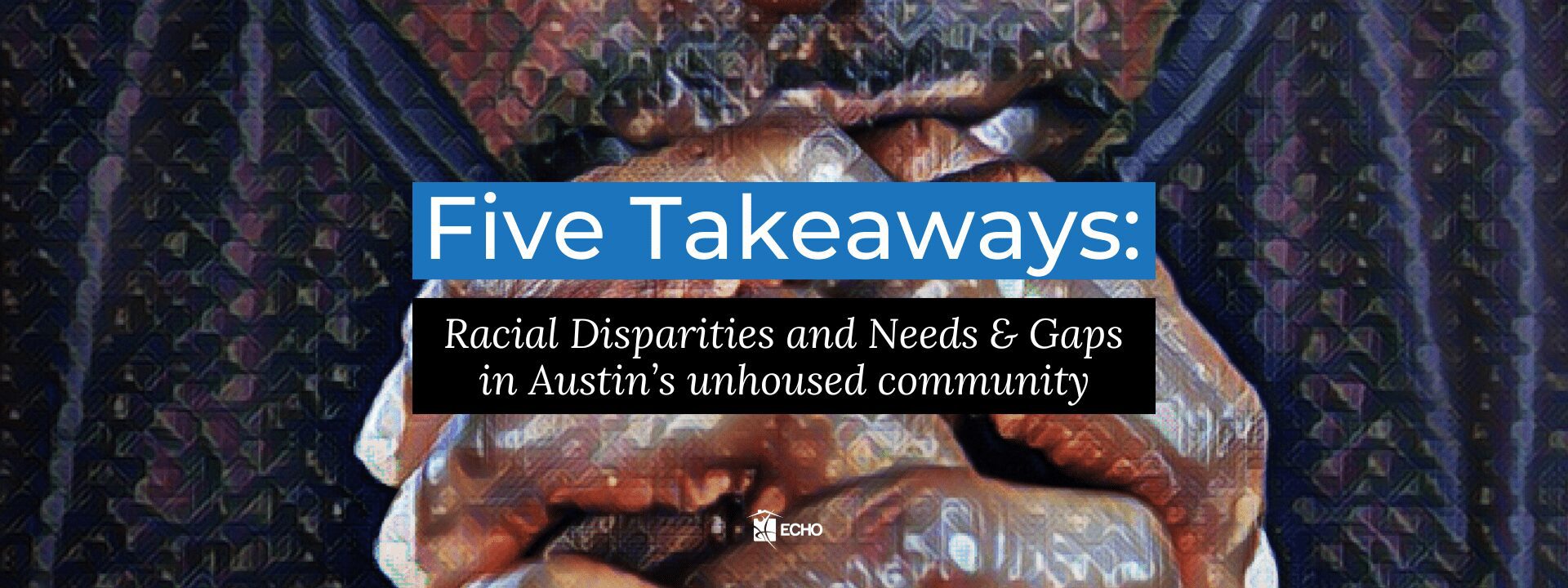Five Takeaways: Racial Disparities and Needs & Gaps in Austin’s unhoused community
AUSTIN – It’s getting harder to afford a place in Austin, and longtime Black and Hispanic/Latinx residents face the most severe effects, according to two new reports from the Ending Community Homelessness Coalition (ECHO).
ECHO’s Research & Evaluation (R&E) Team published the 2022 Racial Disparities and Needs & Gaps (PDF) reports last month. These annual reports, which analyze data collected in 2021 through our community’s central person-level database, help inform where the Homelessness Response System should focus efforts and resources.
Here are five takeaways from the two reports, both of which are available on our Data & Reports page.

1. Black and Brown Austinites are especially at risk of homelessness.
A Black Austinite is still at least six times more likely to experience homelessness than a white Austinite. This is due to systemic racism in many systems that often intersect with housing insecurity, like the criminal legal system, education, healthcare, policing, employment, and many more. The Homelessness Response System has taken steps to respond to the disparities we see in our system, like implementing a new equity-centered housing screening tool, but these downstream disparities persist because of the upstream impacts of systemic racism.
Austin’s unaffordability is also displacing longtime Black and Brown residents. Data from housing assessments in the six months between October 2021 and March 2022 show almost half (44%) of Black people and more than half (54%) of Hispanic/Latinx people were born or raised in Austin, compared to a quarter of white people.

“The legacy of Austin’s racist history has implications on who keeps and who loses their housing in Austin today,” writes Claire Burrus, ECHO’s Research & Evaluation Manager and the Racial Disparities Report’s author.

2. Community-level factors continue to make housing hard to find and maintain.
Skyrocketing rents and a severely limited supply of units mean the private rental market in Austin and Travis County is getting increasingly tight. The overwhelming majority of people housed in Austin get connected to units in private-market apartment buildings, meaning case managers are competing for units with every other renter looking for an affordable place to live. Because of these factors, a person waits on average almost eight months between their last housing assessment and the time they move into an apartment. Nearly half of people have to wait at least six months, and about one in six people (17%) wait at least a year.

Research & Evaluation Analyst Chris Murray, who authored the 2022 Needs & Gaps Report, points out the seasonally adjusted average rent in Austin ($1,869) is higher than the Fair Market Rent (FMR) set by the federal government. A person needs to make $74,760 a year for that rent payment to be considered affordable, more than seven times the amount a person earns from Social Security Administration benefits and about double the general salary of a case manager at a homelessness services agency.
“The current rental market can potentially be untenable for many of our system’s own employees,” Murray writes, “and it is openly hostile to the people we serve, who are earning even lower or fixed incomes.”
ECHO’s Community Housing Team is leading the charge to incentivize property owners to partner with the Homelessness Response System, and recent action by the Austin City Council will help to address some of these gaps.

3. More families with children are experiencing homelessness, and Hispanic/Latinx families are especially at risk.

While most of the people our system serves are single adults, the percentage of multiple-member households and households with children is rising. Thirteen percent of households included children in 2021, up from 9 percent the year before. Nearly half of unhoused Hispanic/Latinx people are members of households with children. Black people and people of two or more races are also more likely to be part of a household with children than white people.
Hispanic/Latinx people are also disproportionately women and girls, compared to Native/Indigenous, Pacific Islander, and white unhoused populations that are disproportionately men and boys.

4. Unhoused Black and Brown people tend to be younger than unhoused white people.
Over half of Black people and about two-thirds of Hispanic/Latinx people seeking housing are under the age of 35. About two-thirds of white people seeking housing are over the age of 35. This important difference illustrates how systemic racism in education, healthcare, policing, employment, and more can affect a person’s housing stability: It takes far less time on average for a person a color to suffer enough setbacks to lose their stability.

“Understanding the tightly interwoven relationships between social systems, housing insecurity, and homelessness would allow for more effective homelessness services to be built out and maintained,” Burrus says.

5. Chronic homelessness decreased as our stock of housing for people with the highest needs grew.
The percentage of people experiencing chronic homelessness (unhoused for more than a year, or on at least four occasions in the last three years totaling at least 12 months unhoused) dropped by four percentage points to 37%. This is still a high rate of chronic homelessness compared to other metro areas, and it stems primarily from the lack of housing options. There is still a long way to go to expand our community’s housing portfolio in order to make a more significant and lasting dent on chronic homelessness.

There are encouraging signs that our community is rising to meet the housing need. Austin/Travis County’s Housing Inventory Count (HIC) shows a substantial increase in the number of Permanent Supportive Housing (PSH) units, the housing intervention that serves people with the highest needs. We also saw an increase in the number of Rapid Re-Housing (RRH) units, another kind of permanent housing intervention. These are critical wins for our community, but as Murray points out, even if every available bed were filled on the day of the HIC, there would be around 3,000 people with no housing option on that day, “even though most project types have seen a modest to moderate increase in capacity since the last HIC.”

